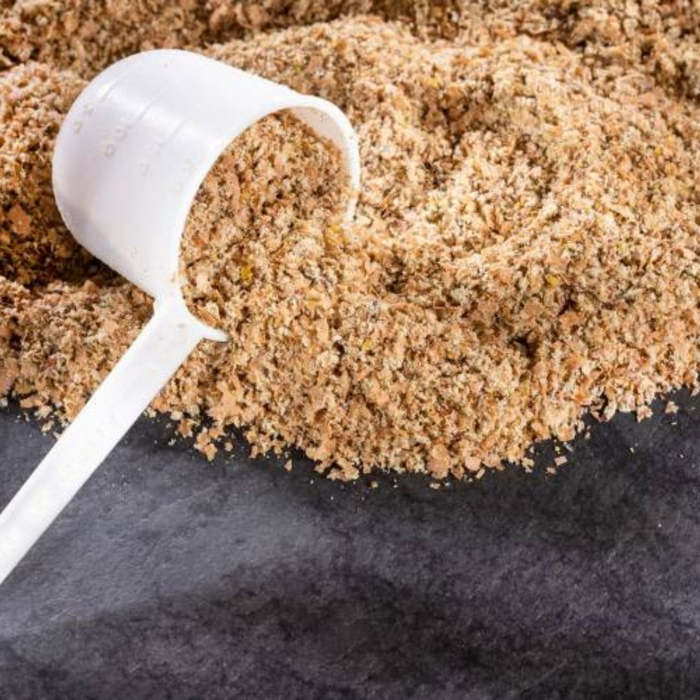
History of psyllium
More than 10 centuries before Christ, Egyptian physicians used psyllium as a laxative and to treat inflammation of the urinary tract. It has also been known for centuries in Europe, Asia and North Africa. In India and China, psyllium was traditionally used to treat diarrhoea, haemorrhoids and hypertension.
In 1998, psyllium had its moment of glory in the United States, when the Food and Drug Administration (FDA) authorised Kellogg to mention the therapeutic virtues of some of its products on its packaging. Food products containing at least 1.7 g of soluble fibre from psyllium are allowed to state on the packaging: "when used in combination with a low-fat, low-cholesterol diet, the soluble fibre from the psyllium seed coatings in this product may reduce the risk of cardiovascular disease.
Description of psyllium
Psyllium seeds are tiny (1,000 seeds weigh less than 2 g) and are black, brown or blond, depending on the species, hence the name, which comes from the Greek word psyllia, meaning flea. Psyllium is mainly cultivated in India, but also in several countries in Europe and the former Soviet Union, as well as in Pakistan.
Psyllium belongs to the category of so-called ballast (or bulk) laxatives, which are made up of fibres with the property of absorbing several times their weight in water.
Experts agree that psyllium, whether black or blond, owes its medicinal properties to the mucilage it contains. Mucilage is a plant substance that swells on contact with water to form a viscous liquid. Apart from the Plantago species discussed in this leaflet, it is reasonable to assume that other psyllium species have similar medicinal properties, provided they contain the same amount and type of mucilage.
Note that the food industry uses the mucilage from the husk of blond psyllium as a thickener or stabiliser in some prepared foods, including frozen dairy products.
Common names: psyllium, psyllium blond, psyllium black, ispaghul.
Botanical names: Plantago ovata (or P. ispaghula), P.afra (or P. psyllium), P. arenaria (or P. indica), P. asiatica, family Plantaginaceae.
Chinese name: Che Qian Zi (seeds).
Parts used: seed and seed coat.
Habitat and origin: blond psyllium (Plantago ovata) is native to India and Iran, while black psyllium (P. psyllium and P. indica) is native to the Mediterranean basin and the Middle East. These annual plants are tolerant of cold as well as heat and drought, and are happy with relatively poor soil.
Benefits of psyllium
- Fights constipation; slightly reduces blood cholesterol levels.
- Prevents cardiovascular disease.
- Treating diarrhoea; relieving symptoms of irritable bowel syndrome; reducing blood sugar in diabetes.
- Relieves symptoms of ulcerative colitis.
- Treating constipation, diarrhea, inflammatory bowel disease; reducing blood cholesterol and glucose levels and preventing coronary heart disease.
Psyllium dosage
When taking psyllium, it is important to drink plenty of water to avoid obstruction of the digestive tract.
When taken in the form of unprocessed seeds, they should be soaked for a few hours in lukewarm water before consumption. When taken as a powder, simply mix it with water or juice and drink it within a few minutes.
Constipation or diarrhoea
- Take 2.5 to 7.5 g, 3 times a day, with a large glass of water (at least 30 ml per gram of psyllium).
- Start with the smallest dose and increase until the desired effect is achieved. It may be necessary to continue the treatment for 2 to 3 days before an optimal laxative effect is achieved.
- If diarrhoea occurs, it may be necessary to increase the dose to 40 g per day (4 doses of 10 g each). Consult a doctor if diarrhoea persists beyond 3 days.
Hypercholesterolemia
Take 10 g to 20 g per day in 2 or 3 doses.
Irritable bowel syndrome, ulcerative colitis, diverticulitis, duodenal ulcer.
Take 10 g, 2 to 3 times a day.
Diabetes (to reduce blood sugar)
Take 10 g to 20 g per day, with meals.
Warning. Self-medication in diabetes can lead to serious problems. When taking any treatment that changes your blood sugar levels, you should monitor your blood sugar levels very closely. It is also necessary to inform your doctor so that he or she can adjust the dosage of conventional glucose-lowering drugs if necessary.
Precautions with psyllium
Diabetes is a serious disease that requires medical supervision. Self-medication with diabetes can lead to serious problems. When taking a treatment that changes your blood sugar level, you should monitor your blood sugar levels very closely. It is also necessary to inform your doctor so that the dosage of conventional glucose-lowering drugs can be adjusted if necessary.
Contraindications
Intestinal or esophageal strictures or any other type of real or suspected gastrointestinal obstruction.
Adverse reactions
Rare cases of allergic reactions have been reported.
Interactions with psyllium
With herbs or supplements
Some experts have suggested that taking psyllium may cause vitamin and mineral deficiency.
With medication
Regular intake of psyllium may require adjustment of diabetes medication.
No hay comentarios:
Publicar un comentario